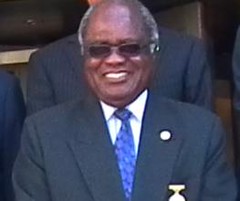
Republic of Namibia President Pohamba, who represents the ruling SWAPO party, has been elected Chair of the Southern African Development Community (SADC) at their August 16-17, 2010 summit.
Originally uploaded by Pan-African News Wire File Photos
sardc.net
SIGNIFICANT progress has been made by Comesa, EAC and Sadc to establish an enlarged Free Trade Area (FTA) encompassing 26 countries in Eastern and Southern Africa by 2012.
A report presented to recent summits of the Common Market for Eastern and Southern Africa (Comesa) and the Southern African Develop-ment Community (Sadc) said the three regional economic communities were committed towards deepening integration through the harmonisation of their trading arrangements.
Chairperson of the tripartite taskforce which is spearheading the implementation process, Ambassador Juma Mwapachu, said a draft plan of action on the FTA has been approved by the three secretariats for adoption at the forthcoming tripartite summit of the heads of state and government expected in early 2011.
However, Comesa and Sadc have already endorsed the roadmap as the framework document for consultations and negotiations on the Tripartite FTA.
The two RECs endorsed the roadmap in their individual capacity as separate trading bodies at their recent summits held in August and September respectively. The East African Community (EAC) is also expected to back the action plan at its summit scheduled for late this year.
“The member states have had sufficient time to review the documents and to propose improvements,” said Mwapachu, who is also the EAC executive secretary.
“It is expected that when the tripartite summit next meets, the heads of state and government will pronounce themselves on the way forward on the establishment of the single FTA.”
The draft roadmap agreed in November 2009 by the three secretariats has 14 annexes covering various complementary areas that are necessary for effective functioning of the proposed regional market.
The main proposal is to establish the FTA on a tariff-free, quota-free, exemption-free basis by simply combining the existing three FTAs.
By the year 2012, it is expected that all the three FTAs will not have exemptions or sensitive lists, thus promoting the smooth movement of goods and services across member states.
Provisions have, however, been made for those that wish to continue maintaining sensitive lists, especially with some big partners such as the European Union. Comesa said it is happy with the document and urged all stakeholders to continue working together for the success of the FTA.
“We endorse the draft agreement establishing the tripartite free trade area, together with the annexes as the basic negotiating documents for consultations and negotiations on the Tripartite FTA,” Comesa said in a communique released after the summit.
Comesa chairperson King Mswati III of Swaziland also said that by working collectively, RECs stood to benefit more as opposed to working individually.
“Working closely with our sister organisations, we have demonstrated that acting jointly and through the tripartite arrangement, we can tackle the most intricate problems facing us in this part of the world,”
King Mswati said soon after assuming the chairpersonship at the September summit hosted by his country.
Sadc, which is expected to host the forthcoming tripartite summit, said it is committed towards moving this integration process forward for the good of the region.
“Summit noted with satisfaction the preparations towards establishing the Comesa-EAC-Sadc Tripartite FTA,” Sadc’s communique reads in part, adding that preparations are now under way for the next tripartite summit.
“To this end, summit mandated the chairperson of council and the executive secretary to consult with member states regarding the dates and venue of the tripartite council and summit meetings,” says the Sadc communique issued after the summit hosted by Namibia in August.
The new Sadc chairperson, President Hifikepunye Pohamba of Namibia, also said in his acceptance speech: “I will work to further strengthen co-operation among member countries with the objective of increasing our capacity to confront and solve the common challenges we face.”
Comesa, EAC and Sadc approved the current tripartite agreement at their inaugural summit of heads of state and government held in Kampala, Uganda, in 2008.
At that historic tripartite summit, leaders from the three RECs resolved to immediately start working towards merging their FTAs into a single grand FTA with the ultimate objective of fast-tracking the attainment of continental integration as envisaged by the African Union.
The creation of a grand FTA with a combined population of about 568 million people and a gross domestic product GDP) of US$625 billion would open borders to literally half of the continent, spanning the entire southern and eastern regions of Africa, from Cape to Cairo.
It would facilitate the smooth movement of goods and services across member countries, boosting intra-regional trade.
No comments:
Post a Comment